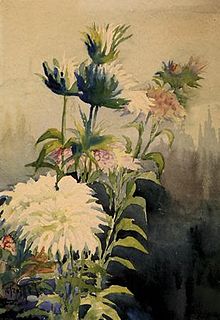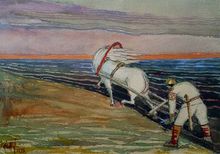Aleksander Promet

Aleksander Promet (born October 29 . Jul / 10. November 1879 greg. In Joala ( Joachimsthal ) in Narva , † 18th September 1938 in Tallinn ) was an Estonian painter and graphic artist .
Life
Aleksander Promet was born into a working class family. His parents, Magnus Promet and Liisa Veimer, lived in the workers' settlement of the large Narva textile factory Kreenholm .
From 1897 to 1904 studied Aleksander Promet at the Stieglitz'schen School of Applied Arts (Санкт-Петербургская государственная художественно-промышленная академия имени А. Л. Штиглица) in the Russian capital Saint Petersburg . He mainly specialized in textile art. With a scholarship from his school, Promet visited numerous European cities such as London , Brussels and Paris in 1905/06 .
In 1906 Promet returned to his Estonian homeland. He first founded an art studio in Tartu, Livonia . Aleksander Promet was a member of the Estonian Art Association ( Eesti Kunstiselts ) founded by Ants Laikmaa in 1907 . In 1909 he took part in the 2nd Estonian Art Exhibition in Tartu, where his folk motifs in particular received great attention. In 1912 special exhibitions followed in Narva and Helsinki . Then he settled as an art teacher in the Estonian capital Tallinn . From 1913 he taught art in Russia. From 1917 to 1919 he worked as a freelance artist in Petrograd .
Promet finally moved to Estonia in November 1919 during the Estonian War of Independence against Soviet Russia . He worked as a drawing teacher in Petseri (1919–1922), which was then part of the Republic of Estonia , in Tõrva (1922/23) and in Paldiski . In 1925 he moved to Tallinn. There he worked as a freelance artist and lecturer.
Promet was closely connected with the Estonian magazine Linda and the radical left-wing publisher and poet Juhan Lilienbach (1870-1928). But his art remained largely apolitical.
Aleksander Promet died in Tallinn when he was only 58 years old. He is buried next to his second wife Olga in the Liiva cemetery.
art
Aleksander Promet is assigned to the "classical modernism" of Estonian art. Shortly before the outbreak of the First World War, he turned against the “neo-modernist approach” of the artist group Noor-Eesti (“Young Estonia”).
Promet is best known for his paintings that dealt with topics of Estonian folklore and mythology . This also includes his scenes from the Estonian national epic Kalevipoeg . Some works deal with nightmarish scenes. In addition, flower and landscape painting belonged to his focus.
Private life
Aleksander Promet married the pianist Marianna Novitskaja in 1911. The marriage produced a son. In June 1921 Promet married Olga Ivanova (1901-1983) for the second time. He is the father of the Estonian writer Lilli Promet (1922–2007).
literature
- Mai Levin (Ed.): Aleksander Promet. Tallinn 1980
- Eesti elulood. Tallinn: Eesti entsüklopeediakirjastus 2000 (= Eesti Entsüklopeedia 14) ISBN 9985-70-064-3 , p. 380
Web links
- Works by Aleksander Promet in the digital collection of the Estonian Art Museum
- Biographical information
Individual evidence
- ↑ PROMET, ALEKSANDER in Eesti biograafiline andmebaas ISIK
- ↑ http://www.kalmistud.ee/g137/haudi?action=hauaplats&filter_hauaplats_kalmistu=21&filter_hauaplats_hauaplats=146163
| personal data | |
|---|---|
| SURNAME | Promet, Aleksander |
| BRIEF DESCRIPTION | Estonian painter and graphic artist |
| DATE OF BIRTH | November 10, 1879 |
| PLACE OF BIRTH | Joala at Narva |
| DATE OF DEATH | September 18, 1938 |
| Place of death | Tallinn |


